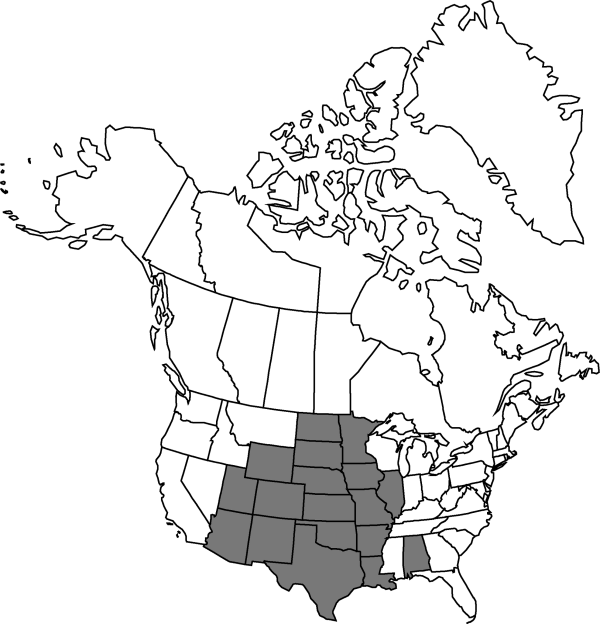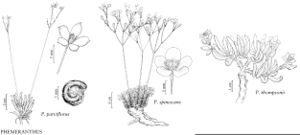Phemeranthus parviflorus
Novon 11: 320. 2001.
Plants to 2 dm; roots elongate, fleshily woody. Stems ± erect, simple or branching, sometimes suffrutescent. Leaves sessile; blade terete, sometimes slightly broadened at base, to 5 cm. Inflorescences cymose, much overtopping leaves; peduncle scapelike, to 15 cm. Flowers usually pedicellate, sometimes sessile or subsessile; sepals deciduous or sometimes persistent, ovate, to 4.5 mm, apex sometimes purplish, acuminate-cornate, thickened; petals light pink to purplish, elliptic to obovate, to 7 mm; stamens (4–)5(–6); stigma 1, subcapitate, sometimes stigmas 3-lobed, or 3, triangular. Capsules ellipsoid or sometimes ovoid, sometimes obtusely trigonous, 3–5 mm. Seeds without arcuate ridges, 0.8–1 mm. 2n = 24, 48.
Phenology: Flowering Apr–Sep.
Habitat: Dry woodland, grassland, chaparral, scrub, canyon washes, mountain slopes and ledges, sandy, usually rocky soil, outcrops
Elevation: 0-2700 m
Distribution

Ala., Ariz., Ark., Colo., Ill., Iowa, Kans., La., Minn., Mo., Nebr., N.Mex., N.Dak., Okla., S.Dak., Tex., Utah, Wyo., n Mexico (Chihuahua, Coahuila).
Discussion
Over its extensive range, Phemeranthus parviflorus varies considerably in several characters, including overall size. Although this variation is more or less continuous, correlating very generally with habitat type and geographic location, some populations that are found toward the limits of the species’ range and that exhibit combinations of tendencies to extremes in the variable characters have been recognized separately. The Alabama populations, few and confined to a very small area on gneiss in the central part of the state, disjunct from the main trans-Mississippi distribution of P. parviflorus, with elongate stems, small flowers, and stigmas often three-lobed, or three instead of one, have been described as Talinum appalachianum. Plants from Arizona with stems slender and tending to elongate, sepals acuminate-cornate and usually purplish, and capsules ovoid have been described as T. gooddingii. Plants from the mountains of New Mexico with elongate stems, subsessile flowers, markedly congested cymes, and acuminate, often persistent sepals have been described as T. confertiflorum (P. confertiflorus).
